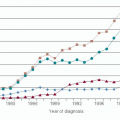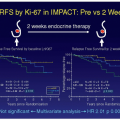Tamoxifen
Endocrine treatment has been shown to reduce recurrence and mortality rates of ER-positive breast cancer and is able to do so in a manner independent of chemotherapy (
6). The Early Breast Cancer Trialists’ Collaborative Group (EBCTCG) recently reported an updated meta-analyses for women in trials that examined the 10- to 15-year follow-up effects of 5 years of adjuvant tamoxifen (
6,
7). This report demonstrated that second primary breast cancers were reduced by 50% in women using tamoxifen. These studies laid the foundation for investigations focused on the development of breast cancer preventive drugs and resulted in a series of Phase III tamoxifen prevention trials in moderate-to-highrisk women with no diagnosis of breast cancer (
Table 20-1). These four Phase III studies follow in chronological order and form the initial timeline for SERM-based therapeutic breast cancer prevention.
Royal Marsden Trial: Recruitment for the Royal Marsden Tamoxifen Breast Cancer Prevention Trial extended from 1986 to 1996 (
8). Initially designed as a pilot trial, the primary goal was to determine the preventive effects of tamoxifen in 2,494 high-risk undiagnosed women. 20-year follow-up results identified a non-statistically significant decrease in overall (hazard ratio [HR] = 0.84, CI 0.64-1.10,
p = .2) and invasive (HR = 0.78, CI 0.58-1.04,
p = .005) breast cancer incidence following tamoxifen treatment (
8). In addition, this study demonstrated a significant effect of tamoxifen on ER-positive (HR = 0.61, CI 0.43-0.864) but not ER-negative breast cancers.
NSABP P-1 (BCPT) Trial: The largest of the SERM breast cancer prevention trials, the National Surgical Adjuvant Breast and Bowel Project (NSABP) Breast Cancer Prevention Trial (BCPT) P-1, recruited 13,388 women from 1992-1996 (
9). The effect of 5 years of tamoxifen treatment (20 mg/day, n = 6,681) on the incidence of invasive breast cancer was investigated in pre- and postmenopausal women at increased risk of breast cancer. A 49% decrease in invasive breast cancer was seen with tamoxifen versus placebo (relative risk [RR] = 0.51, CI 0.39-0.66). These initial results were reported in 1998 and led to early termination of the trial, followed by FDA approval of tamoxifen for treatment of women at high risk of breast cancer. The 7-year follow-up results confirmed the initial study findings, demonstrating reductions in invasive (RR = 0.57, CI 0.46-0.70), noninvasive (RR = 0.63, CI 0.45-0.89), ER-positive (RR = 0.38, CI 0.28-0.50), and ductal carcinoma
in situ (DCIS) (HR = 0.54, CI 0.36-0.80) breast cancers, but no decrease in ER-negative tumor incidence (
9). Although the NSABP P-1 trial also identified toxicity associated with tamoxifen, including increased hot flushes, vaginal discharge, and increased risk of endometrial cancer and thromboembolic events, the study established tamoxifen as the most effective treatment strategy for the prevention of breast cancer, particularly, ER-positive breast cancer.
Italian Tamoxifen Prevention Study: The Italian Randomized Tamoxifen Prevention Trial recruited 5,408 women at normal risk of breast cancer (
10). However, to avoid the undesired side effect of increased incidence of endometrial cancer, the Italian trial limited the study population to healthy women who had previously undergone a hysterectomy. Importantly, many of these women took postmenopausal hormones after their hysterectomy. An unanticipated high subject dropout rate (26%) resulted in early termination of recruitment, but follow-up was continued with the previously enrolled subjects. While no statistically significant reduction in breast cancer incidence was initially observed, the 11-year follow-up report demonstrated a 76% reduction in hormone receptor (HR)-positive breast cancers in high-risk patients previously treated with a bilateral oophorectomy (RR = 0.24, CI 0.10-0.59), suggesting a preventive effect associated with tamoxifen (
10).
IBIS-I Trial: Recruitment for the International Breast Cancer Intervention Study I breast cancer prevention trial spanned from 1992 to 2001 and resulted in the accrual of 7,154 women at high risk for breast cancer (
11). With the primary objective of identifying whether the risk-benefit ratio associated with tamoxifen treatment was sufficient to support its use for the prevention of breast cancer, this study measured breast cancer incidence following 5 years of treatment with tamoxifen (20 mg/day, n = 3,578) versus placebo (n = 3,566). The 96-month follow-up report demonstrated a reduction of risk in subjects not receiving hormone replacement therapy (HRT) while on treatment that was limited to all (RR = 0.62, CI 0.46-0.83), ER-positive (RR = 0.49, CI 0.32-0.74), and DCIS (HR = 0.52, CI 0.27-0.99) breast cancer, although a non-statistically significant decrease in ER-negative breast cancer was reported. In addition, 5 years of tamoxifen treatment was associated with an improved long-term risk-benefit ratio characterized by a cancer preventive benefit persisting for 10 years and a reduction in toxicity after stopping treatment (
11).
Adverse Events Associated with Tamoxifen Treatment: Across the four large-scale Phase III tamoxifen cancer prevention trials (all treating with 20 mg/day for 5 years, except the Royal Marsden Trial, which included 8 years of treatment), endometrial/uterine cancer and thromboembolic and cardiovascular events constituted the most common adverse events (
8,
9,
10 and
11). Other negative side effects most consistently reported within these studies included cerebrovascular events, vaginal symptoms, and hot flushes or cold/night sweats (
Table 20-2). In addition, an increase in risk of cataracts was observed in subjects receiving tamoxifen versus placebo in the NSABP P-1 (21%) and IBIS-I (0.4%, not statistically significant) trials. Most negative effects related to tamoxifen treatment did not persist beyond the active treatment period, and while long-term follow-up reports demonstrate no significant increase in total or cause-specific death, neither do they demonstrate a significant improvement in survival among subjects taking tamoxifen versus placebo (
Tables 20-2 and
20-3).
Endometrial/Uterine Cancer Increased risk of endometrial cancer following treatment with tamoxifen was reported in the Royal Marsden, NSABP P-1, and IBIS-1 Trials. The first published evidence of this was in the 1998 interim analysis of the Royal Marsden study that, by the 20-year followup, identified a 2.5-fold increase in endometrial cancer for subjects who had received tamoxifen versus placebo (
8). The NSABP P-1 and IBIS-1 Trials have also reported a 1.5- to 3.4-fold elevated risk of endometrial cancer associated with tamoxifen therapy in participants ≥50 years of age (
9). The majority of all endometrial cancer cases (53 in the tamoxifen arm, 17 in the placebo arm) were classified as International Federation of Gynecology and Obstetrics (FIGO) (
12) stage I.
Thromboembolic and Cardiovascular Events Primary incidences of thromboembolic and cardiovascular events consistently reported in the four trials were in increased rates of stroke and venous thromboembolic events. Strokes were 25% lower for subjects in the tamoxifen arm of the Royal Marsden Trial (
8); however, the NSABP P-1 (
9), IBIS-I (
11), and Italian (
10) trials reported non-statistically significant increased rates of stroke/cerebrovascular accidents in the tamoxifen study arm. Increased incidence of deep vein thrombosis and overall thromboembolic events was reported in the tamoxifen arms of the Royal Marsden (
8), IBIS-I (
11), and NSABP P-1 (
9) trials.
Risk vs. Benefit: In an analysis of the risks and benefits associated with tamoxifen treatment for the prevention of breast cancer, Gail and coworkers concluded that these are dependent on the age, race, and breast cancer risk level of the individual (
13). They described the increased risk for deep vein thrombosis, endometrial cancer, pulmonary embolism, and stroke, predicting 15, 16, 15, and 13, respectively, additional cases per 1,000 women following 5 years of tamoxifen treatment. In addition, differential efficacy of tamoxifen was age and race dependent, with the overall benefit defined as 97, 53, and 1 fewer cases for invasive breast cancer,
in situ breast cancer, and hip fractures, respectively, per 1,000 women treated with tamoxifen for 5 years.
Due to the variation in risk-benefit effects and ratios for African American women versus white women, the Gail model, originally developed to predict risk in white women using the NCI’s Breast Cancer Risk Assessment Tool (www. cancer.gov/bcrisktool), has been updated specifically for African American women. This risk assessment model, known as the Women’s Contraceptive and Reproductive Experiences (CARE) model, more accurately predicts risk of breast cancer within this population. Finally, while tamoxifen has been shown to significantly reduce risk of invasive breast cancer by 49%, a greatly increased benefit is seen in women with prior atypical ductal hyperplasia (ADH) and lobular carcinoma
in situ (LCIS) lesions, which exhibit relative reductions of 86% and 56%, respectively (
14).
Preventive Therapy is Now Standard of Care: Collectively, the results of the tamoxifen trials, particularly the dramatic results of the NSABP P-1 breast cancer prevention trial, led to FDA approval of the SERM tamoxifen as a viable therapeutic strategy for breast cancer risk reduction. This decision, representing the first approval of a preventive agent for breast cancer risk reduction by the FDA, has led to the acceptance of tamoxifen as the standard premenopausal endocrine therapy for the prevention of breast cancer, especially ER-positive breast cancer.
In 1999, based upon the collective results of these four Phase III randomized clinical trials investigating the effects of tamoxifen in the prevention of breast cancer, the American Society of Clinical Oncology (ASCO) published a review of the data with recommendations for its use as a cancer preventive therapy (
15). The most recent ASCO guidelines include tamoxifen therapy (20 mg/d for 5 years) as a treatment option for long-term (≥10 years) risk reduction of invasive ER-positive breast cancer in premenopausal women ≥35 years of age with LCIS or a 5-year projected absolute risk of breast cancer ≥1.66% (
16). However, tamoxifen should not be used in women with a history or at high risk of deep venous thrombosis, pulmonary embolism, or cerebral vascular accidents. In addition, ASCO guidelines recommend avoiding tamoxifen use in individuals who are immobilized, pregnant, nursing, or receiving HRT. Despite FDA approval and consensus recommendations by ASCO and other professional organizations, tamoxifen is very rarely used for breast cancer prevention due to patient concerns about side effects and a lack of demonstrated survival benefit from tamoxifen use in this setting.







